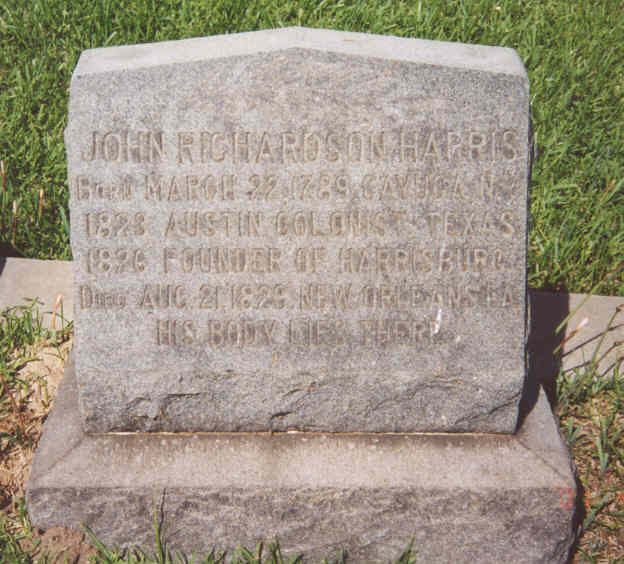The Founding of Harrisburg
On the 16th of August, 1824, the Mexican Government, acting through its Commissioner, Baron de Bastrop, and “Estevan F. Austin, Empresario for the establishment of a new colony in this Province”, granted a league of land to John R. Harris, “native of the United States of America”. Captain John Richardson Harris (he commanded a company of the line in the War of 1812) was a native of New York State, the great-grandson of another John Harris who founded Harrisburg, the capitol of the State of Pennsylvania.
That league of land, nearly a mile wide and more than six miles long on the western side, is that part of Houston's East End which runs from Brays Bayou on the north to about Bellfort Boulevard on the south, and approximately one-half mile on either side of Broadway. For a hundred years the northeastern corner of the league was the town of Harrisburg.
The earliest map of the original plat of the Town of Harrisburg is dated 1826, and showed streets at right angles forming 25 blocks, numbered 1 through 25. Block 3 was the Harris home site. A slightly later map added Blocks 26 through 33, running east and west on the south side of the original plat. The town measured about 3188 feet on its south boundary, and about 4250 feet on its west boundary, inclusive of Blocks 26 through 33. Each block, except blocks 1 through 7, was platted for eight lots. The principal street would seem to coincide with present-day Broadway.

The caption on the above illustration reads: "The above is a sketch of the town site of Harrisburg, showing 33 numbered blocks. The original plat was dated 1826 and showed Blocks 1 through 25. Blocks 26 through 33 were added at a later date, perhaps before 1830. Block No. 3 was the site of the Harris home. The "Town of Hamilton" and "North Harrisburg" were not on the R. J. Harris League, and were never developed by the owners of the land.
John Richardson Harris
Captain John Richardson Harris (he commanded a company of the line in the War of 1812) was a native of New York State, the great-grandson of another John Harris who founded Harrisburg, the capitol of the State of Pennsylvania. He was born on September 21, 1791, and on May 7, 1813 he married an exceptional young woman named Jane Birdsall. Four children were born of that marriage: DeWitt Clinton Harris, Lewis Birdsall Harris, John Birdsall Harris and Mary Jane Harris, who would in time marry Captain Andrew Briscoe.
As so many others did, the Harrises moved west, finally stopping at St. Genevieve, Missouri. It was here that John Harris decided to go to Texas. He aligned himself with the venture of Stephen F. Austin, thus becoming one of the “Old Three Hundred” Texas colonists. He accompanied his wife and small children as far as Vincennes, Indiana, and then turned south to New Orleans. His family never saw him again.
Selecting his league (4428 acres) at the junction of the Buffalo and Brays Bayous, Harris set about platting a townsite, building a home, and doing all the other things necessary for a colonist to do. Perhaps the first industry in what is today the Houston metropolitan area was his steam sawmill. John Harris quickly prospered and was joined by his brother, David. Together they purchased one or more schooners, and one of these may have carried the first Texas cotton to market in New Orleans.

In August of 1829 he sailed one of his vessels to New Orleans but arrived there in the midst of a yellow fever epidemic. On August 21, 1829, John Richardson Harris died, one month less than 38 years old.
This might have ended the Harris story except for the fact that the brother, David Harris, managed his brother's affairs for another four years, until 1833, when Jane Birdsall Harris felt DeWitt Clinton old enough to accompany her to Texas. From the time she arrived in Harrisburg in 1833 until her death in 1869, Jane Birdsall Harris never left the place, except in the face of the enemy.
For the most part, the information on this page is taken from a pamphlet, The Story of Old Harrisburg, written by L.L. Walker, Jr., as a community service project of the Rotary Club of Harrisburg, published by Harrisburg Bank, date unknown.